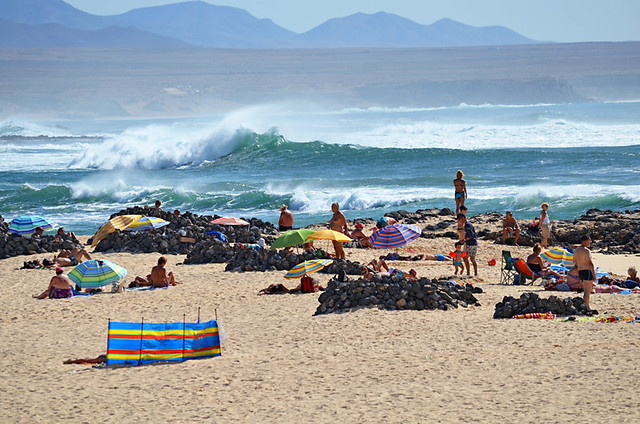In the words of Jim Diamond, I should have known better. For years we’ve thought of the second largest of the Canary Islands as little more than a collection of beaches. Where we’ve made the effort to notch up time on the other Canary Islands, Fuerteventura has remained off the radar. What a mistake that was.
I should have known better because I’ve learnt over the years that the image of the Canary Islands which are popular holiday destinations is generally coloured by the people who stay in the biggest holiday resorts. Ergo, it is often a skewed one.
Fuerteventura is no different. Fuerteventura was a surprise that shouldn’t have been a surprise.
Fuerteventura Beaches

Fuerteventura is known for its beaches and for the perpetual breeze that attracts the surfing community to endless white sands. And they do seem endless in parts. You can read all you like about Fuerteventura having wonderful beaches (all 150km of them) but it’s only when you set eyes upon their vastness that their scale whacks you in the solar plexus. These are Sahara Desert type beaches with dunes you could easily get lost in.
Fuerteventura Resorts

There aren’t many. The main one is at Corralejo and on initial approach it looks like many other Canary Island resorts; same sort of interchangeable bars and restaurants aimed at a mass sun-seeking market. Head to the narrow streets of the old town around the harbour though and it’s a different scene with a mix of fishermen’s cottages, bohemian bars and arty restaurants. Wherever there are surf dudes you get interesting places to eat and drink. This part of Corralejo has a fab vibe and looks great.
Waves

There’s a reason championship board surfing competitions take place on Fuerteventura. The name, meaning strong winds, is a bit of a clue. Some folk claim the name isn’t to do with being windy but a reference to the ‘strong adventure’ undertaken by the first conquistadors. It’s a nice story.
Lighthouse – Fishing Museum

Lighthouses fascinate me. Lone sentinels lighting the way for weary mariners. A lighthouse keeper battling a storm to keep his beacon of hope alight. Lighthouses never fail to conjure up romanticised imagery. This one at El Cotillo doubles as the Museum of Traditional Fishing. I love the way there are lots of mini stone pillars reflecting the faro’s shape on the paths surrounding it.
The Fuerteventura Landscape

The greatest revelation on Fuerteventura is the magical landscape. I’m a fan of lush and leafy but there is something mesmerising about Fuerteventura – the sun arcing across the land brings changes in colour to the hills and valleys throughout the day; the most eye-catching being when vibrant orange hues contrast against the azure intensity of the sky. The oldest of the Canary Islands has had time to calm down, its volcanic curves are softer, more feminine, than the more violent looking terrain of its near neighbour, Lanzarote. This island feels closer to Africa than any other Canary Island… and that’s not just because geographically it is.
Las Salinas Fuerteventura

Man and nature working together to create something we all have on our dining room tables, yet rarely do we think about how it got there. Las Salinas doubles as a salt museum but the real attraction are the salt pits with their mini mountain ranges of white gold.
Fuerteventura Cheese

It seems incredible that an island as arid as Fuerteventura would be a haven for goats, but it is. There are more goats on Fuerteventura than people. Not only that, these goats produce some of the best goats’ cheese in the world, regularly winning awards, including Super Gold Medals at the World Cheese Awards.
Barbary Squirrel

Apart from rabbits, you don’t see many animals in the wilds of the Canary Islands which is why the cute and cheeky Barbary ground squirrel is an attention grabber. Although common in North Africa just across the water, the animal doesn’t really belong here. The story goes they were introduced as pets in the 1960s, some escaped and clearly liked the environment so much they got right into making whoopee at every chance. Now it’s believed there are more than a quarter of a million of them scuttling around, striking cute poses for the visitors.
Windmills of Fuerteventura

The overwhelming sense may be that you’re beneath an Africa sky on Fuerteventura, but occasionally the long straight roads and open plains feel as though they could be in the U.S of A. This notion is aided and abetted by tall metal windmills that look as though they belong in the American prairies. Which they do as most are American made, in a style that was famous in the first half of the 20th century.
Aloe Vera on Fuerteventura

You don’t really expect fields of anything on Fuerteventura, which makes these aloe vera carpets all the more of a pleasant shock. I knew they produced aloe vera on the island but I didn’t think it would look like this. The ruddy plants blend perfectly into the land, almost camouflaged until you get up close and see their sun-yellow spikes – pure natural harmony. It’s a good all round description for Fuerteventura.
Jack is co-owner, writer and photographer for BuzzTrips and the Real Tenerife series of travel websites as well as a contributor to lots of other places. Follow Jack on Google+




Glad you discovered some of Fuerteventura’s many special traits.
We lived there for seven years, both our children were born there, hence it has a special place in our heart.
There is something magical about the red earth, as special kind of warm glow … although it drives you mad when the wind blows and it gets everywhere!
Don’t forget to mention the lovely inland villages too!
Thanks Lisa, the villages will be getting a mention – we thought Betancuria was particularly pretty of the ones we saw. We got really lucky with the wind, hardly a breath. Completely agree about the earth, incredible.